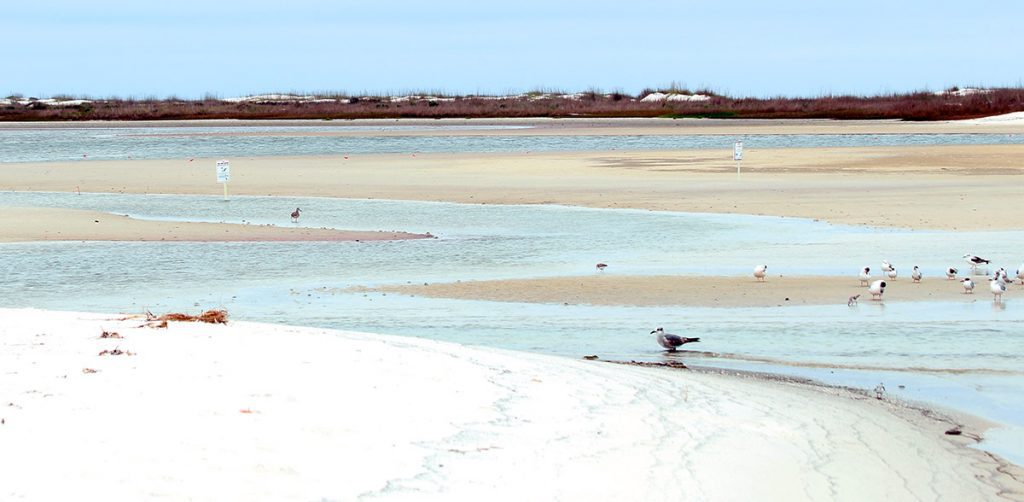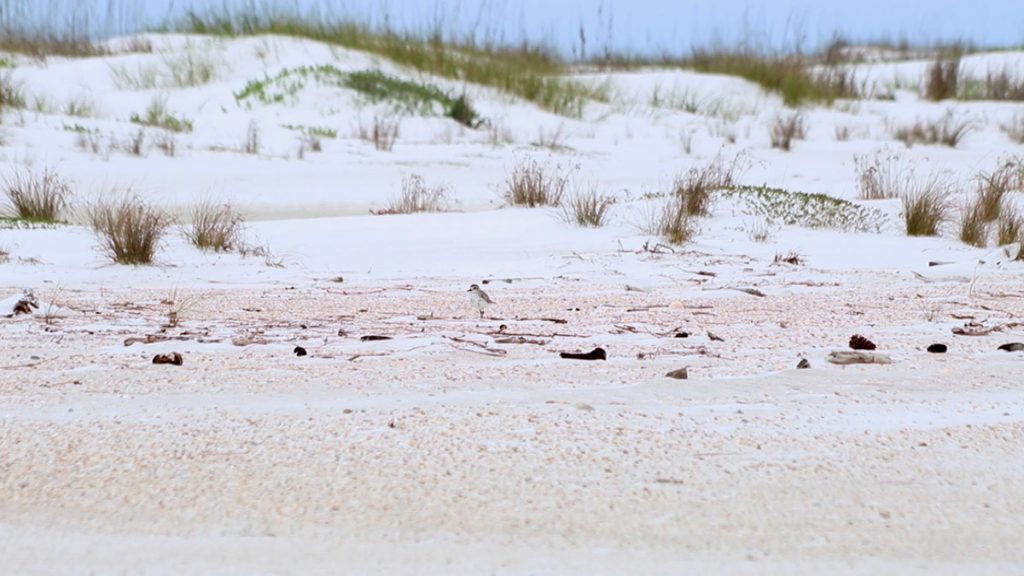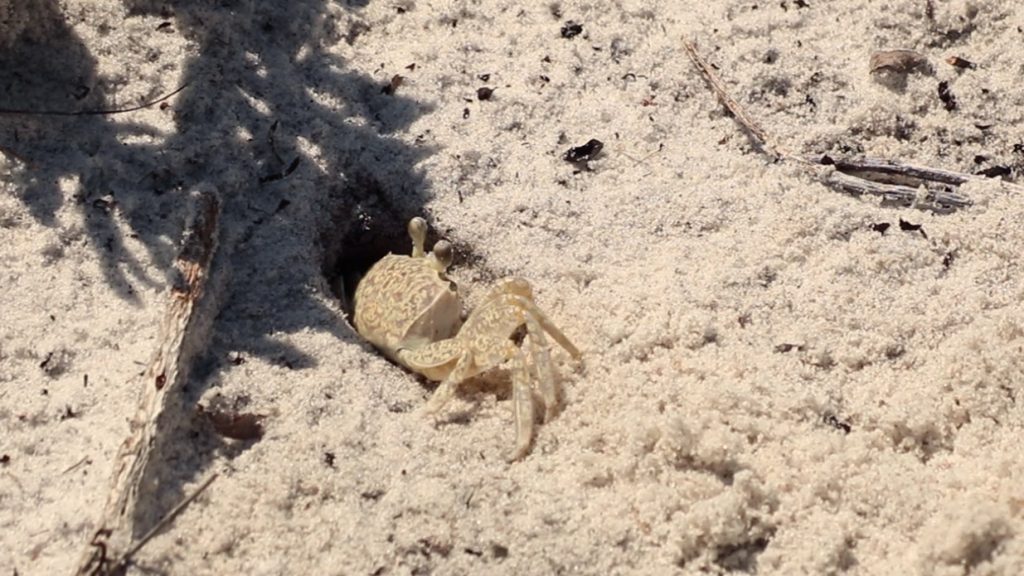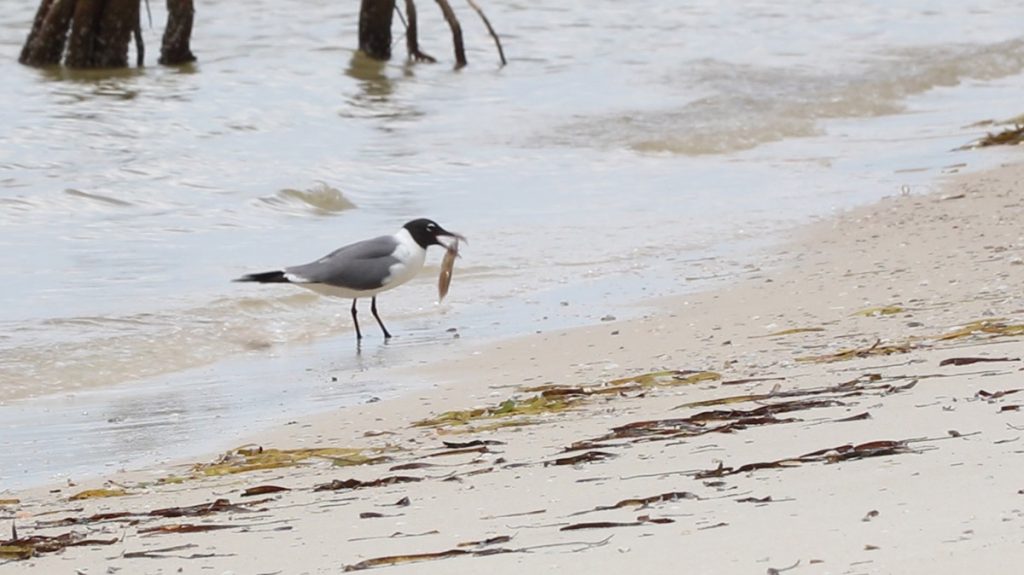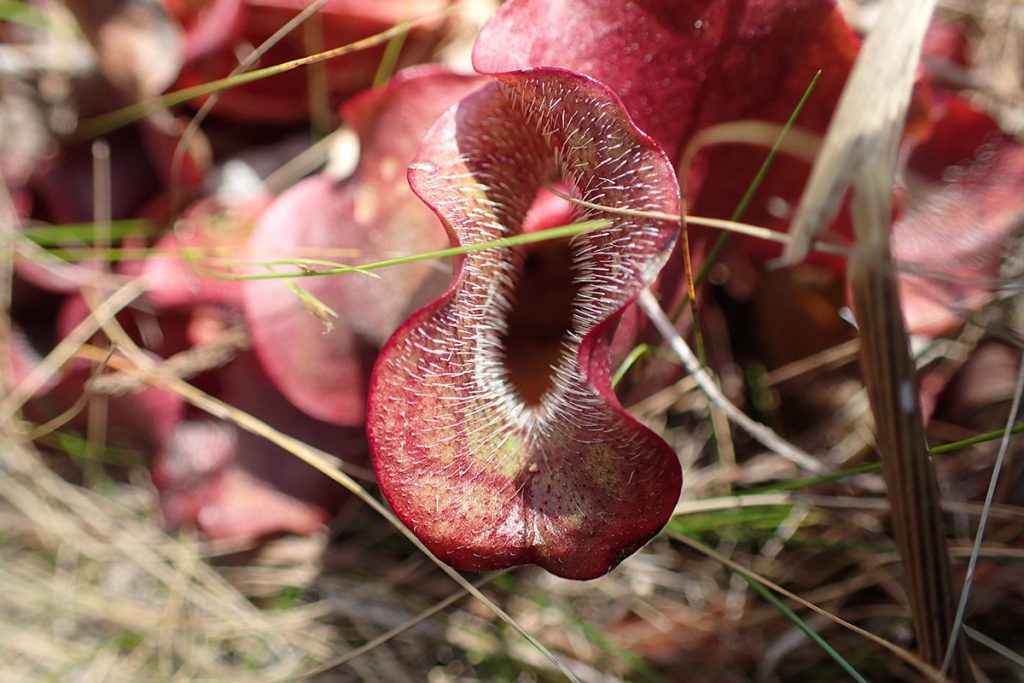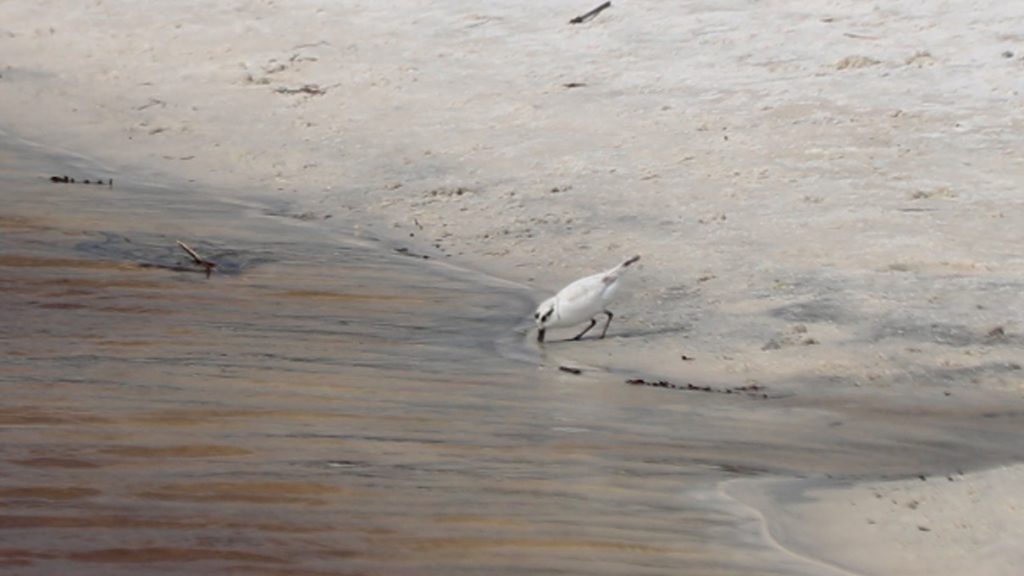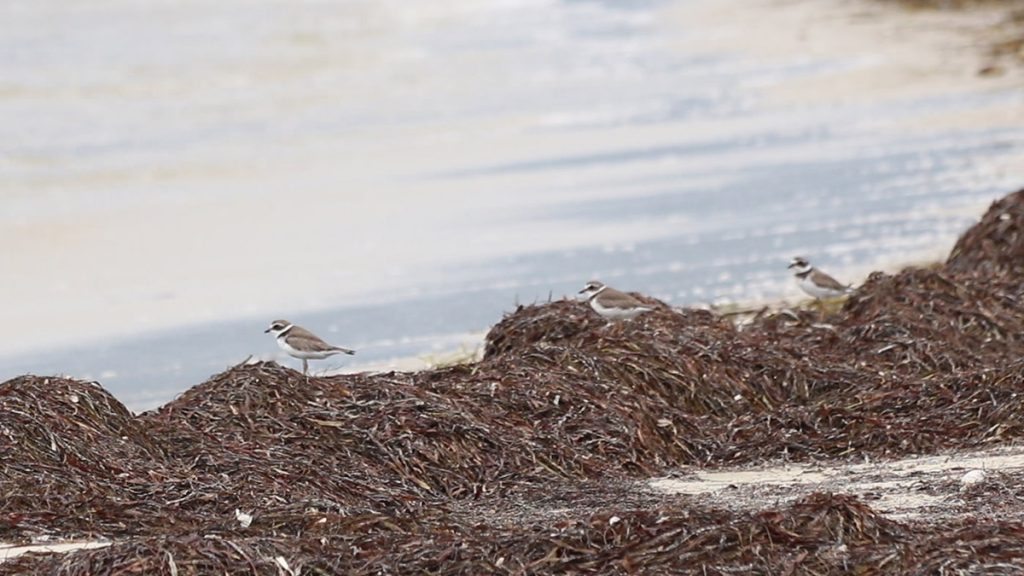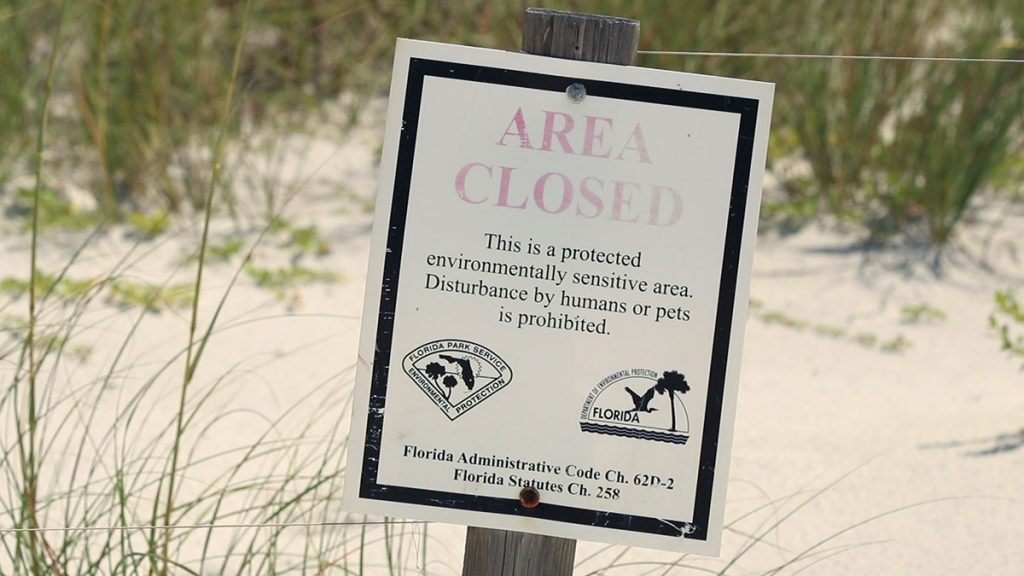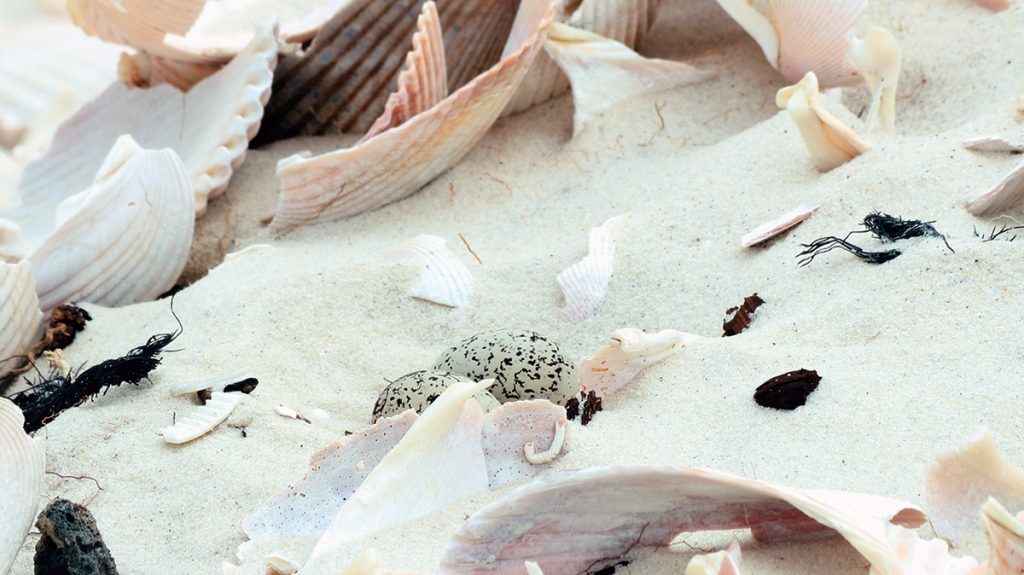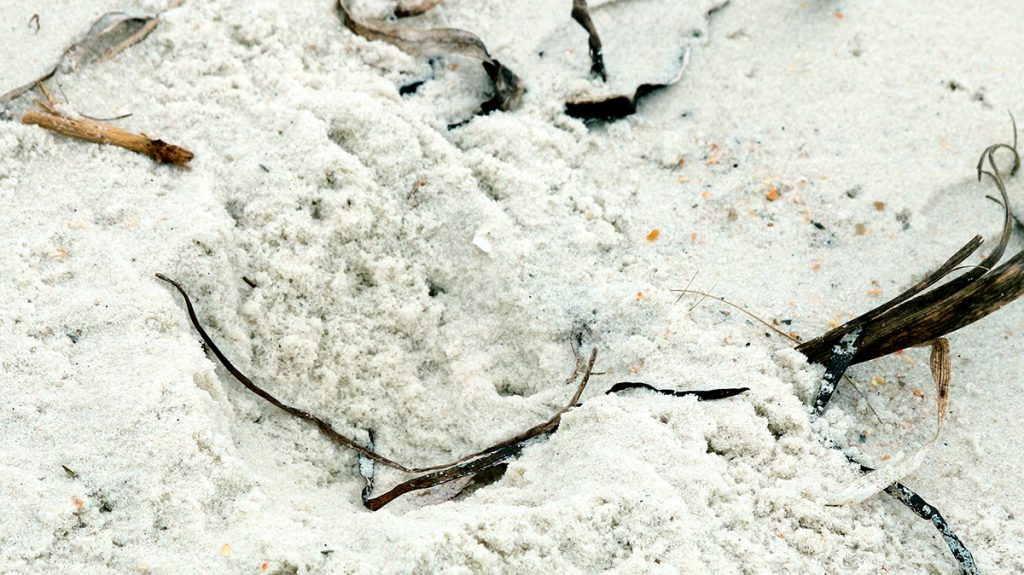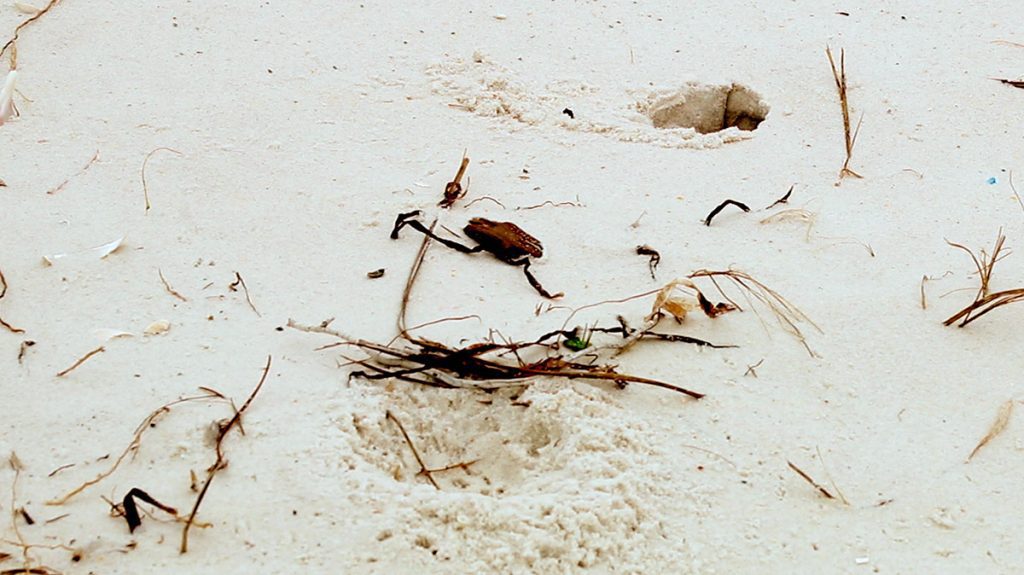Today, we head to the remotest part of St. Joseph Peninsula State Park for some beach time. Here is one of the most productive snowy plover nesting areas in north Florida. In a couple of weeks, we go to Deer Lake State Park as Florida Fish and Wildlife bands newly hatched chicks.
Subscribe to the WFSU Ecology Blog to receive more videos and articles about our local, natural areas, and subscribe to the WFSU Ecology Youtube Channel
Rob Diaz de Villegas WFSU Public Media
When the shoot ends, we ride back along the beach. I sit in the back of the UTV facing out, watching the tip of St. Joseph Peninsula recede behind us. I’m a life long Floridian, and I’m seeing something I’ve never before seen in our state: uninterrupted miles of sand dunes. There are no condos or hotels towering behind them, and no boardwalks crossing over top of them. It’s no wonder snowy plovers like to nest here.
“Saint Joseph [Peninsula] State Park, we kind of call it the snowy plover factory.” says Caity Reiland-Smith. Earlier, she and a team from Florida Fish and Wildlife checked plover nests in the remotest part of park. It’s a place full of shorebirds, and not so full of people.
I’ve camped at this park a few times in the tent/ RV camping areas not far from Eagle Harbor parking area. Eagle Harbor is the hub of activity in the park, near the most accessible beaches. Walking past the camping loops, however, you find a seven mile long trail, along which you can camp at one of seven primitive sites. You need to obtain a permit from the ranger station before heading out on the Maritime Hammock Trail, and there are no amenities along the way. But it’s an opportunity to hike through rare coastal scrub habitat.
Alternately, you can walk along the beach.
Either path leads you to the tip of St. Joseph Peninsula, where we find the ideal conditions for snowy plovers to make their nests. Places this suitable have become scarce, and the species has suffered for it. That’s why FWC pays such close attention to these nests. And by banding the chicks after they hatch, they’ve learned a lot about their behavior. Today, and in a follow up post in a couple of weeks, we’ll get to know this bird, the people who study it, and the threats facing it.
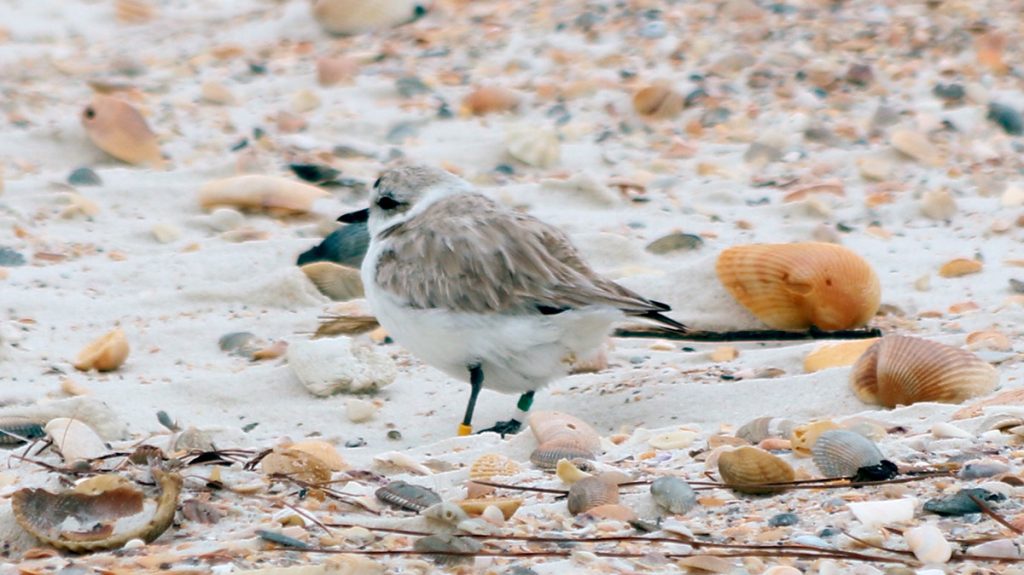
Banded snowy plover near the tip of St. Joseph Peninsula, in Saint Joseph Peninsula State Park. In our next video, we’ll dive deeper into the banding process, and what it has taught us about snowy plovers.
Earlier that morning…
We head out in two UTVs, bumping down the nature trail. It’s late March, and it still hasn’t warmed up. When we emerge onto the bay side, the wind is brutal. The Gulf side has a more spacious beach, but here, facing Saint Joseph Bay, we’re on a thin, uneven strip of sand. Sometimes it’s easier to drive the UTV a little bit in the water. Other times, passengers get out as the UTV negotiates a steep sandy slope.
Eventually, we stop a few hundred yards from the first nest, SJ01, and the crew begins to assemble tripods and scopes. From a distance, it’s hard for me to see what we’re looking for. Snowy plovers practice a minimalist aesthetic when it comes to nest building. But there it is in the scope, two eggs in the sand, among some broken shells and bits of dried grass.
Snowy plovers nest in sandy pockets along the edge of dune vegetation. They like their nests in an open space, where they can see approaching predators, but adjacent to vegetation, where chicks can seek cover after they hatch. It’s a specific combination of site traits. And they’re solitary nesters, so it’s not like a group of snowy plovers can find such a spot and form a colony. Each nest needs its own space.
And they need space from humans. To a snowy plover, we’re a large threatening animal. If we walk near their nests, we may scare the parents away, leaving the eggs vulnerable to ghost crabs and laughing gulls. And when we leave food trash on the beach, we attract fish crows, another egg predator.
The problem for snowy plovers is- we like the beach. Condos and hotels and restaurants have taken the place of favorable dune habitat along much of the bird’s range. And large crowds start showing up on the beach during the warmer months when plovers nest. It’s a combination of factors that has spurred a decline in the overall snowy plover population.
Snowy Plovers in the Gulf of Mexico | North Florida is Where It’s At
“We don’t have historic numbers for snowy plovers in Florida.” Says Raya Pruner, FWC’s Shorebird Project Manager for the panhandle. “What we do know is that the coastline has been developed all across the state, on the Gulf and on the Atlantic. Across the Gulf- and I’m going to exclude Texas here- but Mississippi, Alabama, Louisiana, and Florida, the majority are in Florida.”
Of course, Florida is perhaps the biggest beach destination in the country. But not all of Florida is the same. If you have a second, pan this Google map down and around the peninsula. Do you notice the development along the coast, especially by the beaches?
Now, let’s look at the panhandle. Pan the map left and you’ll see a marked difference.
The peninsular map had back to back municipalities along the coast- less green and more concrete. The panhandle map has large green spaces- large tracts of protected land.
“In Florida, 80% of the snowy plover population occurs in the panhandle.” Raya says. And, “in fact, the only places that snowy plovers still occur, particularly in the panhandle, are areas where we have large intact public lands.”
The panhandle is known for its natural beaches. But the plovers need a little more than relatively secluded beaches and dunes.
Not just the Ecosystem, but the Ecosystem Upstream of the Ecosystem.
“Another area is a water sound,” says Marvin Friel, FWC coastal shorebird biologist. “Birds use those freshwater/ saltwater outlets to forage.”
Places where fresh water flows into salt water are ecologically important for many reasons. Here we find sensitive estuary ecosystems, which are full of food for foraging shorebirds. The health of these habitats relies on good conditions locally as well as upstream throughout the watershed.
I interviewed Raya and Marvin at Deer Lake State Park, home of a coastal dune lake of the same name. Last year, I covered a large scale effort to restore longleaf forests and pitcher plant bogs around creeks feeding Deer Lake and Camp Creek Lake. Decades of fire exclusion had changed the ecosystem, and the way water flowed through it.
The restoration is being funded with penalty funds from the 2010 BP spill. This is a pot of money aimed at helping coastal communities and ecosystems damaged by the spill. So why is it being spent miles from the coast? Because those healthier forests would send more and cleaner water to the outfall of Deer Lake, where the lake periodically meets the Gulf, and where snowy plovers forage for food. And snowy plover populations in the Gulf were hit hard by the spill.
Snowy plovers also like to forage in seagrass wrack. This is made up of older blades of seagrass that slough off and make way for new growth. It washes up on the shore in large mats, full of small aquatic creatures like isopods, and on land it becomes shelter for insects. In other words, it’s full of animals that plovers like to eat.
Years ago, we did a video on seagrass beds and the many ecosystem services they provide. But it’s an ecosystem in global decline.
So while this is a bird that lives on the beach, it is connected to longleaf forests and seagrass beds.
How to Act Near a Snowy Plover Nest
Now, the lack of condos across much of our local coasts doesn’t mean that it’s devoid of people. For a lot of us, these are the best beaches to visit. And if we’re not aware of snowy plovers and their nests, we can scare them off and endanger their broods.
The first thing you’ll notice along dune habitat during nesting season is that they’re roped off with signs prohibiting entrance. That protects the nest to an extent, but you don’t have to be right on it to scare the parents off.
“If you’re visiting a beach during summer months,” Raya says, “and you come across a beach that has signage up for shorebirds, what we ask is that people stay back. Even if you don’t see birds nesting. Many of these birds are inconspicuous and hard to see. They’re relying on camouflage to avoid predators.”
If you can, shorebird advocates recommend staying 300 feet away from nesting areas. That might be a hard distance to eyeball, and tides might affect how much beach there is for you to walk on. But a good rule of thumb is to walk along the water, and not by roped off dune areas.
Also, keep an eye out for the broken wing display. You can see it in the video, starting at 3:02. The bird feigns an injury to make it appear to be a more attractive meal to a predator (that’s you), moving you further and further away from the nest.
“If you ever see that, that means you are too close. Back up!” Raya says. “And remove yourself from the situation until that bird responds and returns to its normal behavior, whether it’s incubating or brood rearing its chicks.”
Audubon Shorebird Stewards
It may seem like a lot of inconvenience for little birds you can barely see when they’re standing on the sand.
This summer, we visited my wife’s family in coastal Massachusetts. There, the roped off areas were protecting piping plovers, a winter visitor to Florida beaches. The Harbormaster didn’t just rope off the area next to the nest and ask that we stand back. Whole sections of coast were closed off, and shorebird monitors employed by the Harbormaster chased anyone off who wandered close by. Amy’s cousin was yelled at for jogging on the road next to a nest with a jogging stroller, for fear that the motion would frighten the parents away.
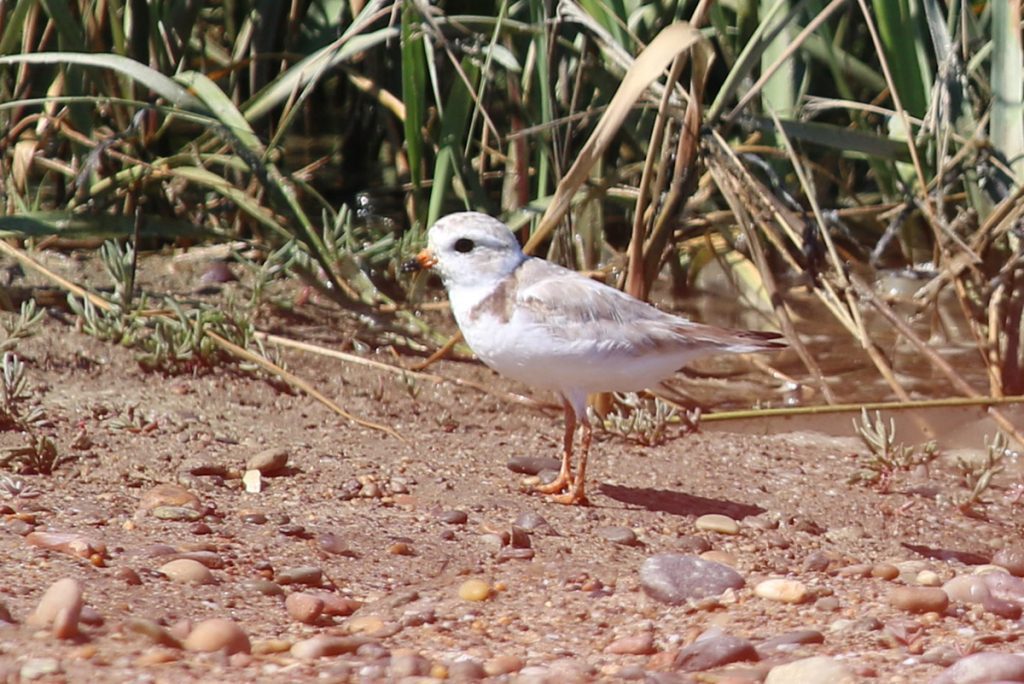
Newly fledged piping plover (they opened the area after the chicks fledged) foraging at the edge of a salt marsh near Duxbury Beach, Massachusetts. Piping plovers are the plover that most closely resembles snowy plovers.
I sensed a little resentment towards the birds, or at least the thoroughness with which they were protected, when I talked to some folks up there.
On Florida beaches, we have more freedom. We can walk near nests or in foraging habitat, as long as we stay on the right side of the ropes. In fact, the ropes can give us a sense that we’re not doing any harm as long as we don’t climb into the dunes.
That’s why Florida Audubon has volunteers stationed by nesting sites during the breeding season. Shorebird stewards keep people from entering restricted areas, and educate beach goers on shorebird habits and biology. From them we learn that while we are allowed to walk near nests, we should give them a wide berth and look for broken wing display.
I’ve watched stewards in action, and they take a gentle approach with passers by. Many times, people passing the nests know little about the birds, and once they hear about them, are willing to give them a wider berth.
Audubon also trains volunteer beach docents, who plan activities to try and educate the public in a fun way.
If you’re interested in learning more about either program, you can visit Florida Audubon’s website.
Snowy Plover Nesting Habits
Meanwhile, back on St. Joseph Peninsula…
Caity Reiland-Smith and her crew check to see if an adult is on the nest, and spot both parents nearby. Next, they turn their scopes to the sky to look for aerial predators. She and Marvin are about to head in, potentially scaring off the parents and leaving the eggs defenseless. They won’t do this if a threatening animal is nearby.
I go in with them. I’m instructed to follow in Marvin’s footsteps, as he’s carefully watching where he steps. We walk slightly up the side of a dune, to a slope covered with broken shell. Two eggs lie in the sand, with a minimal amount of debris around them. Caity calls this nest furniture. Biologists think that plovers arrange these items to help them find nests, as their eggs are well camouflaged in the sand.
Marvin points out a disturbed patch of sand:
“When they decide to nest, they make pre-nesting scrapes,” Marvin says. “[The male] makes these scrapes in different locations, basically in a territory. And the female decides which one they like.”
The female may notice some factor or other that disqualifies a scrape- maybe a ghost crab burrow nearby.
We only spend five minutes at the nest. The idea is to check the health of the eggs and then leave quickly so that the parents can get back to their nest.
Snowy plover eggs take 28 to 30 days to hatch. FWC and park staff monitor the eggs during this time. They look for predator tracks around the nest:
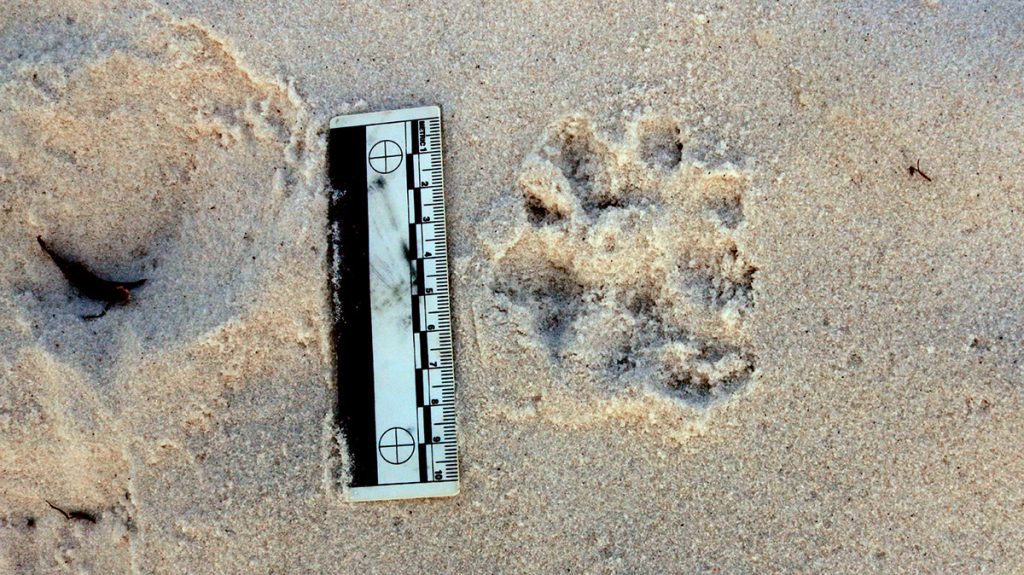
River otter tracks near a snowy plover nest Otters are a potential egg thief, though they’ve never been documented taking eggs here. According to Raya Pruner, “Common mammalian predators on the beach include, coyote, raccoon, opossum, and gray fox.”
They keep close track of these nests, so they know more or less when they’ll hatch. At another nest, Caity picks up the eggs to see if there are any little cracks, evidence that the bird is trying to break out. She then listens to it.
When the birds do hatch, FWC will band them. We’ll see that in action in a couple of weeks, when we head to Deer Lake State Park for part two of our snowy plover adventure. As we’ll see, banding and tracking banding birds has taught biologists a lot about snowy plover behavior.
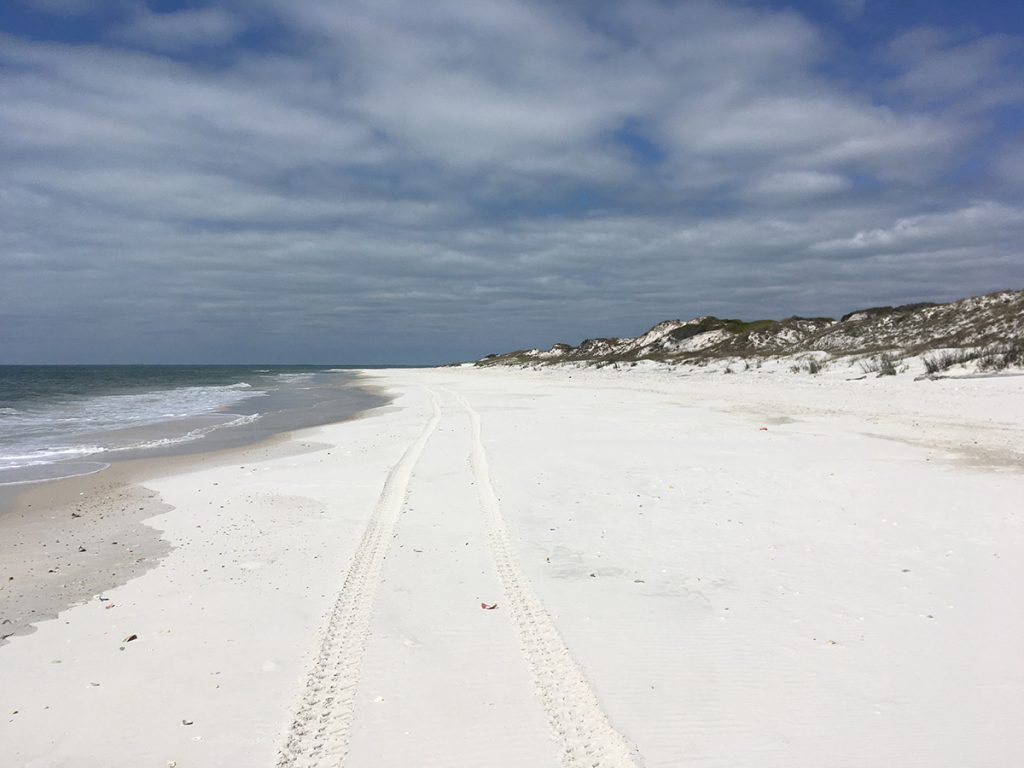
I feel like there are many more stories to be told out here, on the wild end of St. Joseph Peninsula. I hope to return and spend some time here.

